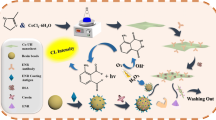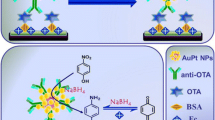Abstract
A competitive electrochemiluminescence immunoassay was established based on the isoluminol-H2O2 (ABEI-H2O2) system catalyzed by cobalt hydroxide (Co(OH)2) to detect florfenicol residues in food. First , ultra-thin two-dimensional Co(OH)2 nanosheets were used as the catalyst of ABEI-H2O2 system, and excellent catalytic effects were acquired by catalytic decomposition of hydrogen peroxide with cobalt ions. Then, bimetal PdAg (Pd/Ag) alloy nanoparticles were used as a bridge to connect ABEI and antibody due to their good biocompatibility; Pd/Ag alloy nanoparticles also had a catalytic effect to further amplify the ECL signal in the system due to the synergistic catalytic effect of the bimetal. A competitive immunoassay strategy was used to detect florfenicol, where the florfenicol in the sample will compete with the antibody for the limited binding sites on the coating antigen. The ECL immunosensor for florfenicol detection shows high sensitivity, with a linear range from 10−4 to 102 ng mL−1, and a detection limit of 3.1 × 10−5 ng mL−1, where the scan potential was varied from 0 to 0.6 V vs Ag/AgCl . This work was the first to use Co(OH)2 nanosheets and bimetal PdAg catalytic signal amplification methods to design the sensor, which provides a novel, convenient and reliable strategy for ultra-sensitive detection of florfenicol, and other biological small molecules.
Graphical abstract
A novel ECL immunosensor based on ABEI-H2O22







Similar content being viewed by others
References
Liu Z, Qi W, Xu G (2015) Recent advances in electrochemiluminescence. Chem Soc Rev 44:3117–3142
Dong Y, Zhou Y, Wang J, Zhu J (2016) Electrogenerated chemiluminescence resonance energy transfer between lucigenin and CdSe quantum dots in the presence of bromide and its sensing application. Sensor Actuators B-Chem 226:444–449
Fu Y, Ma Q (2020) Recent developments in electrochemiluminescence nanosensors for cancer diagnosis applications. Nanoscale 12:13879–13898
Wang Z, Pan J, Li Q, Zhou Y, Yang S, Xu J, Hua D (2020) Improved AIE-active probe with high sensitivity for accurate uranyl ion monitoring in the wild using portable electrochemiluminescence system for environmental applications. Adv Funct Mater 30:2000220. https://doi.org/10.1002/adfm.202000220
Hao N, Wang K (2016) Recent development of electrochemiluminescence sensors for food analysis. Anal Bioanal Chem 408:7035–7048
Zhang A, Miao C, Shi H, Xiang H, Huang C, Jia N (2016) A novel solid-state electrochemiluminescence sensor for atropine determination based on Ru(bpy)32+/carbon nanospheres/Nafion composite film. Sensor Actuators B-Chem 222:433–439
Zhang M, Peh J, Hergenrother P, Cunningham B (2014) Detection of protein-small molecule binding using a self-referencing external cavity laser biosensor. J Am Chem Soc 136:5840–5843
Zang R, He Y, Yuan R, Chai Y (2016) An ultrasensitive electrochemiluminescence immunosensor based on zeolitic imidazolate frameworks encapsulating spherical graphite crystals. Electroanal Chem 781:284–288
Yang H, Wang H, Xiong C, Chai Y, Yuan R (2018) Highly sensitive electrochemiluminescence immunosensor based on ABEI/H2O2 system with PFO dots as enhancer for detection of kidney injury molecule-1. Biosens Bioelectron 116:16–22
Yang M, Liu C, Qian K, He P, Fang Y (2002) Study on the electrochemiluminescence behavior of ABEI and its application in DNA hybridization analysis. Analyst 127:1267–1271
Wang C, Zhang N, Li Y, Yang L, Wei D, Yan T, Ju H, Du B, Wei Q (2019) Cobalt-based metal-organic frameworks as co-reaction accelerator for enhancing electrochemiluminescence behavior of N-(aminobutyl)-N-(ethylisoluminol) and ultrasensitive immunosensing of amyloid-β protein. Sensor Actuators B-Chem 291:319–328
Yang H, Wang H, Xiong C, Chai Y, Yuan R (2017) Intramolecular self-enhanced nanochains functionalized by an electrochemiluminescence reagent and its immunosensing application for the detection of urinary beta2-microglobulin. ACS Appl Mater Interfaces 9:36239–36246
Jiang X, Wang H, Wang H, Yuan R, Chai Y (2016) Signal-switchable electrochemiluminescence system coupled with target recycling amplification strategy for sensitive mercury ion and mucin 1 assay. Anal Chem 88:9243–9250
Emran M, El-Safty S, Shenashen M, Minowa T (2019) A well-thought-out sensory protocol for screening of oxygen reactive species released from cancer cells. Sensor Actuators B-Chem 284:456–467
Sun Y, Luo M, Meng X, Xiang J, Wang L, Ren Q, Guo S (2017) Graphene/intermetallic PtPb nanoplates composites for boosting electrochemical detection of H2O2 released from cells. Anal Chem 89:3761–3767
De Poulpiquet A, Diez-Buitrago B, Dumont Milutinovic M, Sentic M, Arbault S, Bouffier L, Kuhn A, Sojic N (2016) Dual enzymatic detection by bulk electrogenerated chemiluminescence. Anal Chem 88:6585–6592
Doroftei F, Pinteala T, Arvinte A (2013) Enhanced stability of a Prussian blue/sol-gel composite for electrochemical determination of hydrogen peroxide. Microchim Acta 181:111–120
Yi T, Gong W, Lei Y, Zeng W, Chai Y, Yuan R, Zhuo Y (2018) New signal probe integrated with ABEI as ECL luminophore and Ag nanoparticles decorated CoS nanoflowers as bis-co-reaction accelerator to develop a ultrasensitive cTnT immunosensor. J Electrochem Soc 165:B686–B693
Kitte A, Assresahegn D, Soreta R (2013) Electrochemical determination of hydrogen peroxide at glassy carbon electrode modified with palladium nanoparticles. J Serb Chem Soc 78:701–711
Li P, Yu J, Zhao K, Deng A, Li J (2020) Efficient enhancement of electrochemiluminescence from tin disulfide quantum dots by hollow titanium dioxide spherical shell for highly sensitive detection of chloramphenicol. Biosens Bioelectron 147:111790. https://doi.org/10.1016/j.bios.2019.111790
Zhao J, Liang W, Lei Y, Ou Y, Chai Y, Yuan R, Zhuo Y (2017) An efficient electrochemiluminescence amplification strategy via bis-co-reaction accelerator for sensitive detection of laminin to monitor overnutrition associated liver damage. Biosens Bioelectron 98:317–324
Wei X, Chen J, Ali M, Munyemana J, Qiu H (2020) Cadmium cobaltite nanosheets synthesized in basic deep eutectic solvents with oxidase-like, peroxidase-like, and catalase-like activities and application in the colorimetric assay of glucose. Microchim Acta 187:314. https://doi.org/10.1007/s00604-020-04298-4
Li Y, Zhao C (2017) Enhancing water oxidation catalysis on a synergistic phosphorylated nife hydroxide by adjusting catalyst wettability. ACS Catal 7:2535–2541
Hsu K, Lien C, Lin C, Chang H, Huang C (2014) Immobilization of iron hydroxide/oxide on reduced graphene oxide: peroxidase-like activity and selective detection of sulfide ions. RSC Adv 4:37705–37713
Zeng L, Cao B, Wang X, Liu H, Shang J, Lang J, Cao X, Gu H (2021) Ultrathin amorphous iron-doped cobalt-molybdenum hydroxide nanosheets for advanced oxygen evolution reactions. Nanoscale 13:3153–3160
Chen Y, Zhou S, Li L, Zhu J (2017) Nanomaterials-based sensitive electrochemiluminescence biosensing. Nano Today 12:98–115
Ham H, Stephens J, Hwang G, Han J, Nam S, Lim T (2011) Pd ensemble effects on oxygen hydrogenation in AuPd alloys: a combined density functional theory and Monte Carlo study. Catal Today 165:138–144
Yang F, Yang F, Wang G, Kong T, Wang H, Zhang C (2020) Effects of water temperature on tissue depletion of florfenicol and its metabolite florfenicol amine in crucian carp (Carassius auratus gibelio) following multiple oral doses. Aquaculture 515:734542. https://doi.org/10.1016/j.aquaculture.2019.734542
Li K, Liu L, Clausen J, Lu M, Dalsgaard A (2016) Management measures to control diseases reported by tilapia (Oreochromis spp.) and whiteleg shrimp (Litopenaeus vannamei) farmers in Guangdong. Aquaculture 457:91–99
Pfenning A, Roybal J, Gonzales S, Hurlbut J (2000) Simultaneous determination of residues of chloramphenicol, florfenicol, florfenicol amine, and thiamphenicol in shrimp tissue by gas chromatography with electron capture detection. J Aoac Int 83:26–30
Shen H, Jiang H (2005) Screening, determination and confirmation of chloramphenicol in seafood, meat and honey using ELISA, HPLC–UVD, GC–ECD, GC–MS–EI–SIM and GCMS–NCI–SIM methods. Anal Chim Acta 535:33–41
Tian L, Bayen S, Yaylayan V (2017) Thermal degradation of five veterinary and human pharmaceuticals using pyrolysis-GC/MS. J Anal Appl Pyrol 127:120–125
Yikilmaz Y, Filazi A (2014) Detection of florfenicol residues in salmon trout via GC-MS. Food Anal Method 8:1027–1033
Barreto F, Ribeiro C, Barcellos Hoff R, Dalla Costa T (2016) Determination of chloramphenicol, thiamphenicol, florfenicol and florfenicol amine in poultry, swine, bovine and fish by liquid chromatography-tandem mass spectrometry. J Chromatogr A 1449:48–53
Guidi L, Tette P, Gloria M, Fernandes C (2018) A simple and rapid LC-MS/MS method for the determination of amphenicols in Nile tilapia. Food Chem 262:235–241
Ma G, Wu P, Wu K, Deng A, Li J (2021) A novel electrochemiluminescence immunoassay based on highly efficient resonance energy transfer for florfenicol detection. Talanta 235:122732. https://doi.org/10.1016/j.talanta.2021.122732
Zhang K, Song T, Wang C, You H, Zou B, Guo S, Du Y, Li S (2021) Surface plasmon resonance boost electrocatalytic alcohol oxidation over three-dimensional PdM (M = Au, Ag, Cu) nanosheet assemblies. Inorg Chem 60:7527–7535
Liang Z, Zhang C, Xu Y, Zhang W, Zheng H, Cao R (2018) Dual tuning of ultrathin α-Co(OH)2 nanosheets by solvent engineering and coordination competition for efficient oxygen evolution. ACS Sustain Chem Eng 7:3527–3535
Zhang H, Zhang C, Liu D, Zuo F, Chen S, Yuan R, Xu W (2018) A ratiometric electrochemiluminescent biosensor for Con A detecting based on competition of dissolved oxygen. Biosens Bioelectron 120:40–46
Jiang X, Wang H, Wang H, Zhou Y, Yuan R, Chai Y (2016) Self-enhanced N-(aminobutyl)-N-(ethylisoluminol) derivative-based electrochemiluminescence immunosensor for sensitive laminin detection using PdIr cubes as a mimic peroxidase. Nanoscale 8:8017–8023
Wang Z, Jiang X, Yuan R, Chai Y (2018) N-(aminobutyl)-N-(ethylisoluminol) functionalized Fe-based metal-organic frameworks with intrinsic mimic peroxidase activity for sensitive electrochemiluminescence mucin1 determination. Biosens Bioelectron 121:250–256
Funding
This work was financially supported by the Science Fund from the National Natural Science Foundation of China (No. 21175097, No. 31772053), the Project of Scientific and Technologic Infrastructure of Suzhou (SZS201207), the Project of State Key Laboratory of Analytical Chemistry for Life Science (SKLACLS1716), the Suzhou Industry, State and Local Joint Engineering Laboratory for Novel Functional Polymeric Materials (SYG201636), and the Project Funded by the Priority Academic Program Development of Jiangsu Higher Education Institutions (No. YX10900212).
Author information
Authors and Affiliations
Corresponding authors
Ethics declarations
Conflict of interest
The authors declare no competing interests.
Additional information
Publisher's note
Springer Nature remains neutral with regard to jurisdictional claims in published maps and institutional affiliations.
Supplementary Information
Below is the link to the electronic supplementary material.
Rights and permissions
About this article
Cite this article
Cheng, G., Li, S., Wu, K. et al. Highly sensitive competitive electrochemiluminescence immunosensor based on ABEI-H2O2 system with cobalt hydroxide nanosheets and bimetal PdAg as co-enhancer for detection of florfenicol. Microchim Acta 189, 214 (2022). https://doi.org/10.1007/s00604-022-05248-y
Received:
Accepted:
Published:
DOI: https://doi.org/10.1007/s00604-022-05248-y




